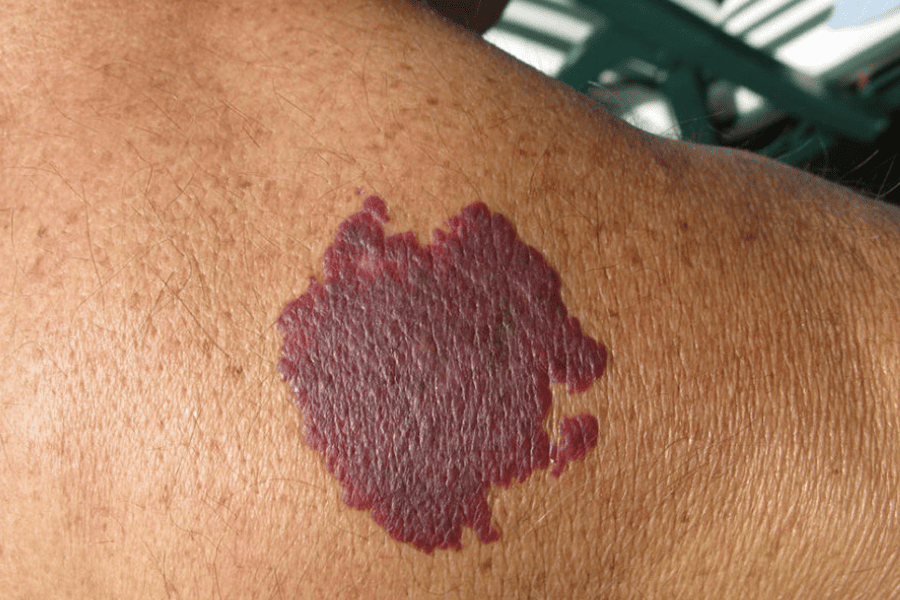Port Wine Stain
Home » Medical Dermatology » Port Wine Stain

port-wine stain
A port-wine stain is among the types of vascular birthmarks that appear pink at birth and tend to darken to a red or purple color as a child ages. This birthmark is tokened with the name port-wine stain due to the color similarity to wine. Around three out of every 1,000 children have a port-wine stain at birth.
Port-wine stains are commonly known as nevus flammeus and can appear on all areas of the body. Common areas include the face, scalp, neck, arms, and legs. These birthmarks can range in size and grow as the child grows. Port-wine stains are initially untextured but can develop a bumpier texture as children age.
Are Port-Wine Stains Harmful?
Port-wine stains do not cause any physical discomfort however, they can take an emotional toll on children. The darkening and growth of the stains as children age can affect their self-esteem and confidence. Port-wine stains can cause a child to feel different than their peers.
A specific pattern of port-wine stains on the skin may indicate the uncommon diagnosis of Sturge-Weber syndrome or Klipple-Trenaunay-Weber syndrome. These syndromes require additional workup to screen for at-risk medical conditions. Your physician at Clear Dermatology & Aesthetics Center will help to determine if you or your child are at risk for one of these syndromes. If a port-wine stain changes later in life, it is crucial to get it checked by a medical professional. Individuals with port-wine stains near their upper and lower eyelids are at a heightened risk of developing glaucoma. The birthmark can be more prone to bleeding when injured, due to the abnormal capillaries and swollen blood vessels that make up the vascular birthmark.
Causes of Port-Wine Stains
These birthmarks can occur from abnormally formed capillaries. These capillaries are dilated and are more stretched out than normal capillaries. This condition is unrelated to genetics, and no specific known causes exist.
Examinations and Testing
A medical provider can diagnose your port-wine stain through a variety of tests and skin evaluations. In some cases, a skin biopsy is needed; while in other cases, your doctor can tell simply by looking at the skin.
Treatment for Port-Wine Stains
Although port-wine stains do not fade naturally, laser treatments have proven to be highly effective in dulling the color of the birthmark. This treatment works by shrinking the birthmark blood vessels with laser energy effectively fading the reddish purplish discoloration of the mark.
Although removing port wine stains entirely is not always possible, they can be treated by a professional. At Clear Dermatology & Aesthetics Center, we offer laser treatments to minimize the appearance of port-wine stains. Laser treatments can lighten the birthmark, making it less visible in areas such as the face and neck.
Port-Wine Stain Procedure
At Clear Dermatology & Aesthetics Center, we proudly offer the VBeam Perfecta “pulsed-dye” laser. Laser treatment often starts during childhood when the tiny blood vessels and birthmarks are smaller. This ensures that the birthmark responds more readily to treatment. Laser treatments can also help diminish port-wine stains in older children, teens, and adults without damaging the surrounding skin. The longer the stain has been on the skin, the more treatment sessions you may require.
Port-Wine Stain Treatment Results
Laser therapy treatments are short, lasting only a few minutes, depending on the size of the birthmark. Treatments should be administered every few months to achieve optimal results. After treatment, your skin can appear red and tender, like a sunburn. Bruising may also be present. Numbing cream, spray, or anesthesia can be delivered to young children.
Schedule a Consultation
If you are seeking an effective treatment for your port-wine stain or vascular birthmark, look no further than the experts at Clear Dermatology & Aesthetic Center. To schedule your consultation, head to our website and fill out an online contact form today!

